Is your manufacturing company ready to grow? Are you on the edge of the next stage of your company’s growth? As a business owner myself, I know what it is like to be ready to take the next steps, while feeling the pressure of making the best decisions. And as someone whose family and extended family has worked in various manufacturing subindustries for generations, I have also witnessed the real-life victories and consequences of big business decisions.
The future of a company’s growth is not something to be taken lightly. And with all of the changes happening in today’s buying journey across all industries, it can all be pretty overwhelming, scary, and sometimes even paralyzing.
But you cannot stay frozen in fear. Or there will only be one inevitable outcome eventually: failure. Many have chosen to live in denial for as long as possible about the effects the internet has had on disrupting their business models and increasing their competition. But everything catches up and that will too. It is only a matter of time. So instead of staying paralyzed and living in a state of denial, I recommend you instead shift your mindset to embrace change and make it a habit if you have not already. Learn to see the upsides of change and adapt. Or your competitors will and your business will suffer. There is a time and place for tradition and classic things like good values, but your manufacturing company’s growth strategy in today’s omnichannel, customer-centric world should not be one of them. It needs to modernize.
So if you are ready to embrace change in order to help your company adapt and thrive, read on.

While many manufacturer businesses incorporated new technology to modernize other parts of their business, such as using robotics or CNC machines in the production process, many have not done the same for their marketing and sales practices. It’s an interesting paradox. But for any business to grow and thrive these days, a strong website is not only important, but essential. A well constructed website is the foundation of the company’s future and is what all other marketing practices center around. Redesigning your website is the first step to evolving your growth strategy. So you can go ahead and pat yourself on the back if you are reading this, knowing that you are now heading in the right direction.
Besides being the center of all of your company’s marketing practices, the importance of a website has also shifted due to the change in how your prospects and customers use it. Customers today are doing most of their own research online before they ever talk with a sales representative. That has had a big impact on not only the importance of your company’s website, but also its fundamental pieces. A company’s website can no longer sit there like a convoluted printed brochure and wait for people to visit and comb through the endless array of options.

These are just a few examples of things that are becoming increasingly important--and expected!--by consumers in all industries. You also need to reduce friction in the entire online experience, which basically means making things easier for the user instead of more frustrating. This includes anticipating your customers’ needs without them having to seek you out and tell you. Because they likely won’t. Instead, they will just go to another site that they find makes things easier and less painful.
And then they will likely be marketed to online after that prospect leaves a competitors’ site with email marketing, social media, or online advertisements that can target customers who previously visited a website. So now, customers are not stuck with one or a handful of options that maybe do not serve their needs best but are the only few options available. The tables have turned and the consumers have the upper hand with an endless array of options being made available to them online. So the days of “build it and they will come” are over as there is much more competition at consumers’ fingertips these days. But your company needs a website that follows all the latest best practices and puts your customers’ needs at the heart of it all before you can start driving more traffic to it and using it as your company’s growth engine. And those things have changed a lot in recent years for many different reasons, technological advances and increased competition being two prominent ones.

Block out some time on your calendar for reading this. Put on some comfy pants and grab a good cup of coffee. Because there is a lot of information in this guide and it really only skims the surface. But it is a start. And that is the only place to begin when beginning a new endeavor. And while change can be scary and seem like a risky move, just remember what the likely outcome is of the opposite when it comes to your marketing and sales growth strategies. So take a deep breath and take this one page at a time but just start. And be sure to share this with anyone else relevant on your team as soon as possible so you can all hold each other accountable to stay the course.

In the past, websites could be pretty simple. Some basic text, some flashy images, and some accurate information about your company were all you really needed to provide. You hoped people ended up on your website if they needed to find out where you were located, how to get in touch with you by phone or email, or what kinds of products and services you provided.
These days, a website does much more. What customers are looking for today is a site that is easy to use, provides helpful information, and gives them multiple ways to engage with the company.
Let’s take a look at some of the innovative ways your website can support and expand your business:
Marketing teams are responsible for generating quality leads for the sales team. The company website is becoming a bigger part of that responsibility. Some examples of tactics focused on website lead generation include live chat, calls-to-action (CTAs), and forms. Although email blasts are still a major marketing tool, they need to be incredibly focused on specific users, based on the information collected during the lead generation process. An old-fashioned website simply won’t result in leads the way that a new, expertly designed one will.

The strength of your website plays a direct role in your sales success. Even if your company existed before the internet was a major influence on consumer behavior, you can’t depend on outdated sales methods. Well, you can, but you will lose out to your competitors, so why would you?
Sometimes the conversation about website-driven sales is too narrowly focused on online vs. in-store sales. That conversation leaves out industries like manufacturing, where neither was the primary method of lead generation or sales for most of the industry’s history. Historically, the manufacturing industry has conducted much of its lead generation through trade shows. Sales teams then contact the leads and take them through the sales process, often using print catalogs and shipped samples to close the sale that is at some point routed to a distributor.
Some questions you may have asked yourself in regards to re-evaluating the sales team’s roles and processes might include things like:
Overall, a gloom-and-doom attitude is not needed here and is the wrong perspective. Sales teams simply need to shift their approach and incorporate the website into their efforts. One way they can do that is accounting for a more educated buyer in their engagements. An educated buyer can quickly fact-check and compare information in a few clicks. So sales reps should know how the company compares to its competitors and be able to articulate that quickly and succinctly. They should also feel comfortable enough with the company website to pull relevant links and other resources to share in order to build credibility and trust, as well as educate.

A key component of today’s sales landscape is education. Educating the public and customers is a way of nurturing leads for the future. Your website should go beyond providing basic product information and instead be a source of education and a reference guide for your customers. Besides information written directly on your website pages, some other common formats for communicating this kind of information include blog posts and downloadable content offers like guides or ebooks. These can also help capture lead information since a user is required to fill out a form before they can view the content. A popular educational content format is video. VIDEO. VIDEO. VIDEO.

But be sure to keep some of these statistics in mind from the Content Marketing Institute’s 2019 Manufacturing Marketing Trends Report as you begin brainstorming educational content to include in your redesigned website…
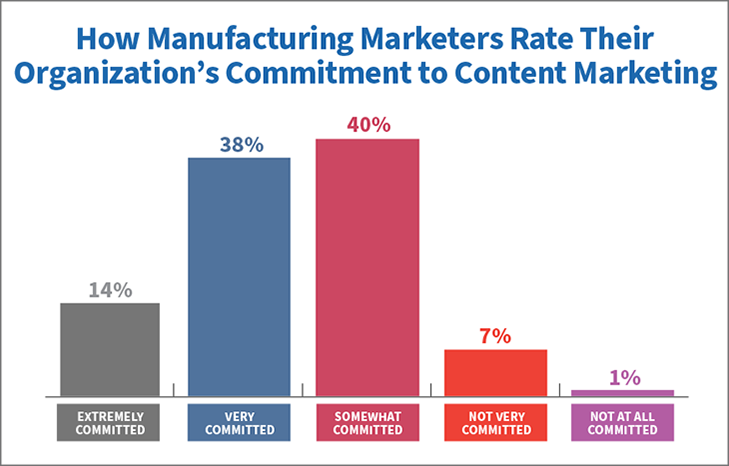
It is clear that companies are trying to acclimate to the changing marketplace faced by manufacturers. The importance of getting on top of this cannot be overstated. For your company to thrive, you need to ask your website to do more than just provide general information about products. You must join the conversation about your industry that is happening online, and one of the best ways to do that is through viewing your company as an educator, not just a manufacturer. I like to think of it as companies operating as their own news rooms, creating and disseminating information their customers can use that is relevant to the company’s product or service and industry, as well as the problems that they solve. Once youcom think of it like that, it can be a lot easier to have fun making the educational part come to life by tapping into experts within your company and industry for their specific knowledge areas and showcasing their expertise online.

I mentioned briefly that the marketing team and website design must be well-connected, and one of the ways to do that is by providing high-quality, easy-to-use website forms. Let’s talk more about that.
As you consider your website’s redesign, one of the things you should prioritize is how you are going to gather information from the people who visit your site. Your web design needs to invite people to voluntarily submit their information so you can start to learn more about them to build relationships with them, and vice versa.

You can do this by encouraging users to sign up for blog emails or special offers. Think of all the times you have visited a website while shopping for something you need and been prompted to provide your contact information in order to gain access to a special promotion or educational resource, like an ebook. Those are some ways you can use your website to learn about visitors who are still in the research phase of their buying journey, so a sales representative can reach out at the right time and with a relevant message that is personalized to their needs. Then the representative should see more success with the prospects they are reaching out to and the prospect has a better experience because the seller already knows so much about them and their interests. For example, if a visitor just downloaded a buying guide related to a specific sector of the business and you have someone who focuses on that sector and territory, they can be notified to reach out to the visitor, instead of a more generalized member of the sales team. This saves an unnecessary step in the engagement and therefore creates a more seamless or frictionless, personalized, and delightful experience for the prospect.
Combine your new role as an educator with your goal of gathering useful information. Think about how beneficial it could be to provide your website visitors with a special information offer, such as an ebook download or a special guide, that is tailored to their specific needs based on where they originally came from (an industry trade show, a Facebook ad, or a search engine) or which company content they have engaged with. Offering this useful content in exchange for their contact information means you are not just begging for a name and an email address. You are providing a useful service for free, and your visitor is not going to forget that. Consider that this guide you are reading now is the result of this kind of education/information exchange!

The final aspect of web design that you should be considering is how connected we are through the internet. When someone shows up on your website, they aren’t just looking at what you are offering. They are also looking at things like what independent review sites, consumer reviews, industry publications, influencers, and opinion leaders have to say about you. A lot of this is done using social media and Google.
When you add icons with links to your social media platforms on your website, they should be obvious and easy to find. Although you may be asking yourself if social media is really all that important for a manufacturing company, the reality is that it is important for all companies.
The CMI report states that 53 percent of manufacturers are already using social media to reach their target audience. In addition, 70 percent of manufacturing marketers increased their social media use for content marketing over the past year. Buyers are engaging with manufacturing companies on social media in a way that drives awareness of industry leaders, so the placement of social media icons and the number of ways to engage on social media should not be afterthoughts to your website design.
All of the items mentioned in this section about the many roles of a modern website relate to the connections that form between individuals, companies, and all the places online where the individual buyer can find out information about the relevant products or services and company they are considering. These connections are the cornerstone of a website redesign, which will be your gateway to new and better relationships in the future.

If you were a student taking a course on web design for manufacturing companies, what would you learn? What would the lessons cover? Consider this section your “fast-track to website redesign class,” taught by your teacher here at Digital Marketing Direction. As a leader in the industry, I can provide expertise to help you figure out where your website currently needs the most work and how to decide what to do next.
So, what do you need to take into consideration as you are planning your redesign? Here are the twelve lessons I’ve learned are the most important.


Use your website to tell a story. You might hear this advice from a lot of website developers, but what does it mean? Which stories are you supposed to tell? First of all, tell your company’s story. Your website should weave your company’s story into every piece of it, just like when decorating a home or office, but there are also specific elements you can incorporate to help communicate it, such as videos and timelines.

ImageNet, a technology consulting firm, does this beautifully. Their website provides the company’s mission statement, but also offers a dynamic and image-filled timeline of their history and how it affects who they are today.
For the website visitor, this provides a way to understand the credibility of the business. Yet it goes beyond credibility. Telling its story is a company’s chance to show off their “secret sauce,” so to speak. Companies use it to show off their culture, approach, and more. It can help to form relationships with people who then view your company as an expert in your niche or like its style, among other things.
ImageNet’s potential customers can understand from this portion of the site where ImageNet excels and who they are as a company. Sharing your company’s story can be a great way to differentiate and build quality connections through strategic content.
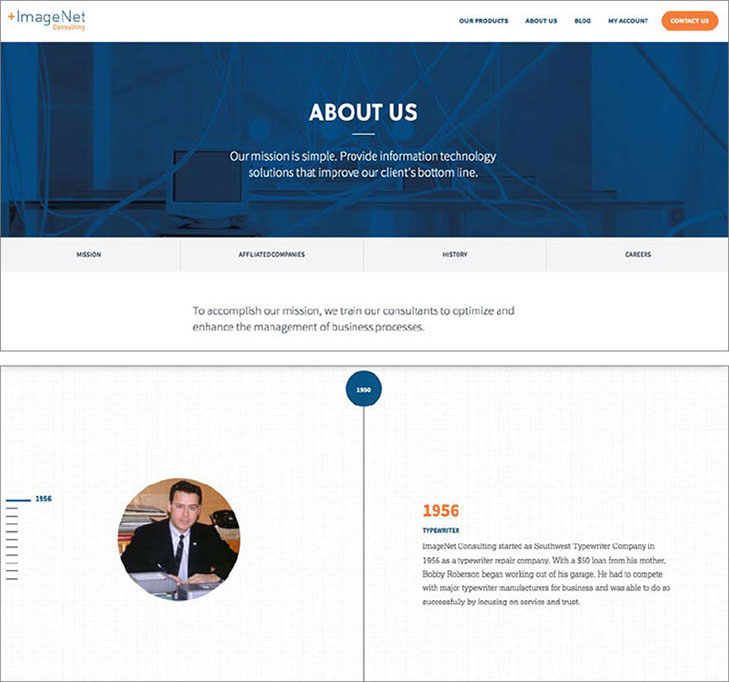

Insights provide bridges between the members of different teams within a company. Understanding customer insights can allow everyone to easily understand not just the demographics of your consumers, but also their needs, wants, interests, motivations, and behaviors.
Persona research is one of the methods that can provide you with digestible, useful, and actionable customer insights. By researching how your best customers found you and why they decided to choose your company over your competitors, who they are, and identifying important trends, you can incorporate that feedback into your communications and other business strategies to help attract similar buyers.

 According to the CMI report, more and more companies are starting to use buyer persona research. In fact, there was an expectation at that time that 66% of respondents would be using persona research by the end of 2018.
According to the CMI report, more and more companies are starting to use buyer persona research. In fact, there was an expectation at that time that 66% of respondents would be using persona research by the end of 2018.
Creating well researched personas is important because consumers’ expectations have shifted. Buyers now expect companies to know more about their products and about their customers, creating a frictionless buying process for the consumer that anticipates their needs.
Today’s consumers expect to be delighted with their experience, and it is your job to delight them. Instead of viewing marketing as a funnel, we are now understanding marketing as a flywheel. The most important part of that shift is recognizing that your customers are what keep everything else spinning. Without them, you have nothing. They have more options at their fingertips than ever before, which is why you have likely heard companies like Amazon talk about how companies need to be not just customer-focused these days, but customer-obsessed. Customers are the center of it all, not just the output at the end of a funnel.
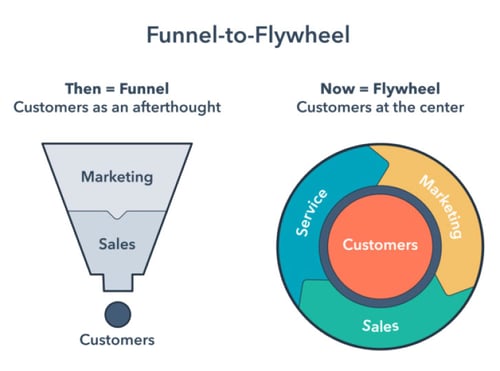

You already know what makes you valuable to your customers. An important question, though, is do they know it?
What makes your company different from your competitors? What do you have to offer that others don’t? Is it exceptional customer service? Expedient order fulfillment? Top-quality products? The very best value and savings?
Be sure that you understand your value proposition, and then figure out the best way to communicate that through your website and connected social media platforms. Positioning is key, and when I say “positioning” I mean making sure that it is clear what your company’s value is in relation to your competitors. In the news industry they say “don’t bury the lede,” which means you should say the most newsworthy part of the story first and then get into the details. It’s a similar concept here. Don’t make visitors have to work hard to figure out what sets you apart. Put that front and center on your site.


UI stands for User Interface, and UX stands for User Experience. These two design concepts influence the ways that a user interacts with a website, and the best UI/UX goes unnoticed by the website visitor because the experience is so flawless and easy - just like good technology.
UX design is the foundation that UI is built on. UX makes sense of the ways that individuals navigate websites, respond to information, and make decisions about what to click on or tap. UI takes the research and decision-making that has gone into UX and creates visual designs that match the user’s logical and intuitive processes.
There are various research methods often used within this discipline, depending on how sophisticated a company is able to get. To demonstrate how even small tweaks to improving UI/UX can have a big impact in improving the look and experience of a website, you can see this before and after image of the homepage for a laser diode manufacturer where we incorporated these concepts:
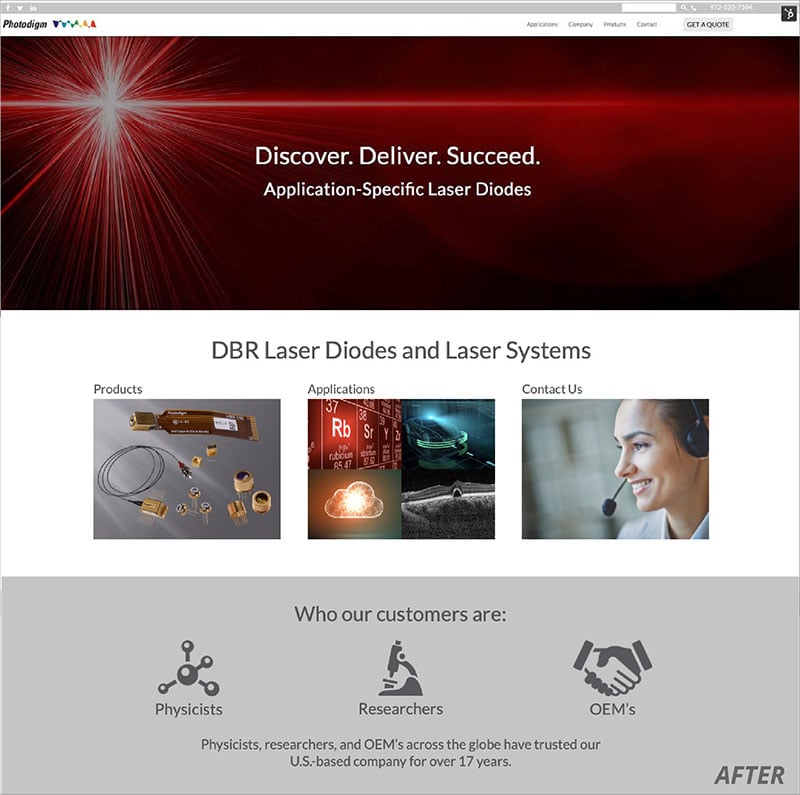

When it comes to designing your site, you have to think like a graphic designer. Like it or not, a website contains a lot of visual components that are more of an art than a science.
Sometimes, even though all of the required information is on a page and it is easy to understand, it just does not look good or does not accurately reflect the brand. This can actually hurt your company’s image and affect potential growth. If your pages need a more artistic vision, you may need to either pull in an expert or assign someone who has a good visual eye on your team some additional training. HubSpot offers video training on creating compelling visuals, with curricula that covers a wide range of design topics, including:

You will want to make sure that person has at least a basic understanding of typography and color theory.
Typography encompasses many things relating to type, especially readability and the purpose of different types. Font choice and size affects the website visitor’s experience in many ways, including whether or not they consider your website to be current, relevant, and easy to read and navigate.
Color theory suggests that large numbers of consumers respond to certain colors in similar ways. Understanding the effect of color on consumers, you can then utilize color to communicate certain ideas, feelings, and moods to your consumers. For example, if you want to communicate an idea in a bold way, red might be a better choice for font color than orange.
Keeping these elements in mind during your redesign will help ensure that your new website looks cohesive, matches your company’s branding, and communicates your desired tone and message.
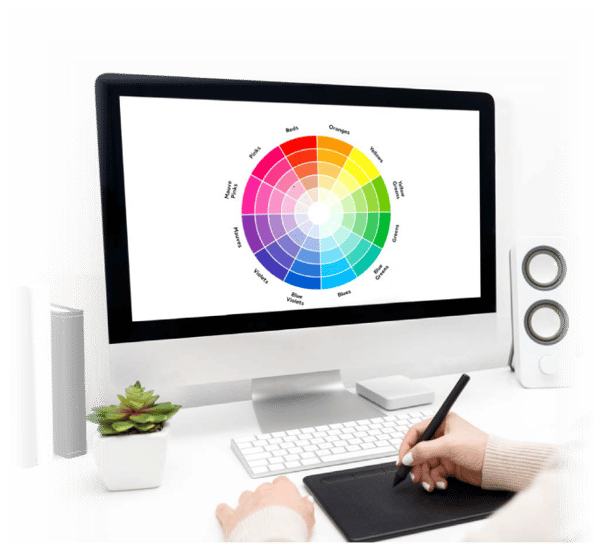

Search Engine Optimization (SEO) is a marketing strategy that focuses on increasing internet visibility in non-paid search engine results. This organic growth means you are not paying for ad space at the top of a search page, but rather, working to help your content come up higher in search results when someone searches for something relevant to your company, products, or services.
SEO is an entire discipline within marketing, so it is impossible for me to give a comprehensive overview. However, you can familiarize yourself with some SEO basics so that when you pursue more knowledge, you have a good foundation.
Because there is increased competition, the algorithms have improved, and people have gotten better at searching online for the exact information they are looking for. It is important that your website content includes strong content relating to your core topics to tell Google those are your company’s main areas of expertise for someone searching for information relating to them so Google sees your website as an authority on them. Including long-form, informational pillar pages is one good way to do that. Therefore, they should be planned into your website redesign.
We were writing about the importance of good content way back in 2014, and while some of the advice has changed since then, the focus on content has not. Long-form articles that are over 1000 words are prioritized by Google and other search engines, and search engine algorithms like content that links back not just to itself, but also to other sources. Google’s algorithms change frequently, but creating strong, informative, helpful content for buyers is the safest and most effective way to have successful search engine optimization. That includes your web pages, not just your blog and downloadable offers like ebooks.
Once you do some keyword research and a website audit to locate opportunities to add or optimize search terms, you might be amazed at how your existing website does not even mention the updated key, basic phrases someone who is searching for your type of product or company might type into Google. And then, on top of that, you may see more peripheral opportunities to tell Google about further key terms related to what your company does that you all are missing out on. For example, if your website includes images that are missing alt text for very specific terms that someone who is looking for your specific product might be searching for online, you are missing out on that traffic.
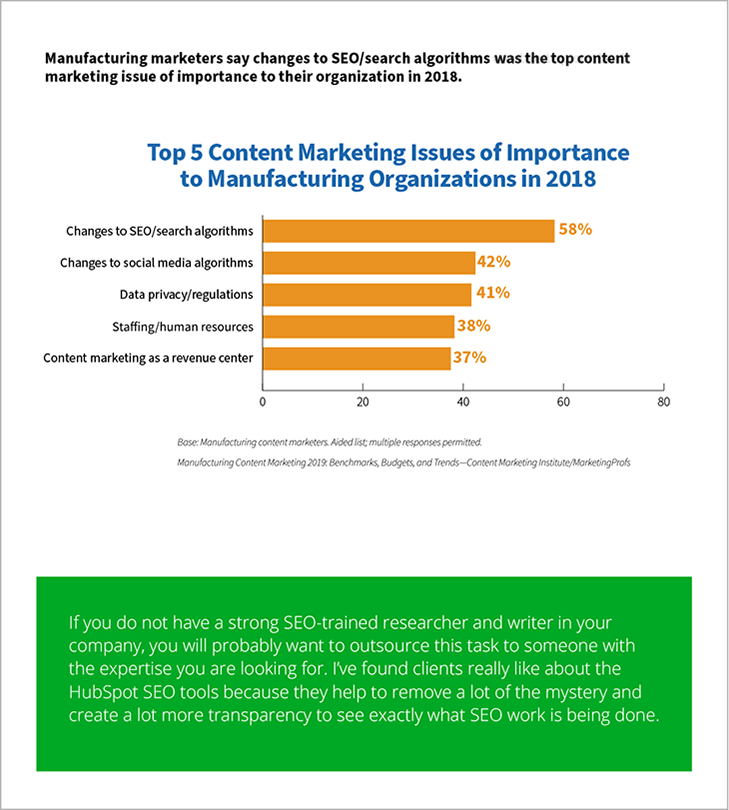

It is one thing to have great traffic to your site, but you need to be capturing potential customer information and creating opportunities for them to make the next step towards a purchase. If you are not doing those things, then your website is not doing as much for growing your business as it could be. This is a problem you can easily solve.
A few years ago, I wrote about some beautiful, conversion-focused websites that made their value proposition clear through their homepage. These homepages aren’t static and boring, but instead are updated regularly with images that are refreshed frequently. Some of the best sites are also personalized to users based on different criteria like gender, job title, or lifecycle stage. This means that a lead could see one main call-to-action on the homepage while a customer sees another. This creates a more relevant experience, captures more information, and either moves prospects along further in their buying journey or further delights existing customers.
MCR Safety’s homepage is a great example of Conversion Rate Optimization (CRO) improvement. They followed my homepage optimization suggestions and updated their homepage to be much more focused on creating clear pathways for visitors to follow, depending on their needs at the time. You can see the updated version with clear call-to-action on the next page.
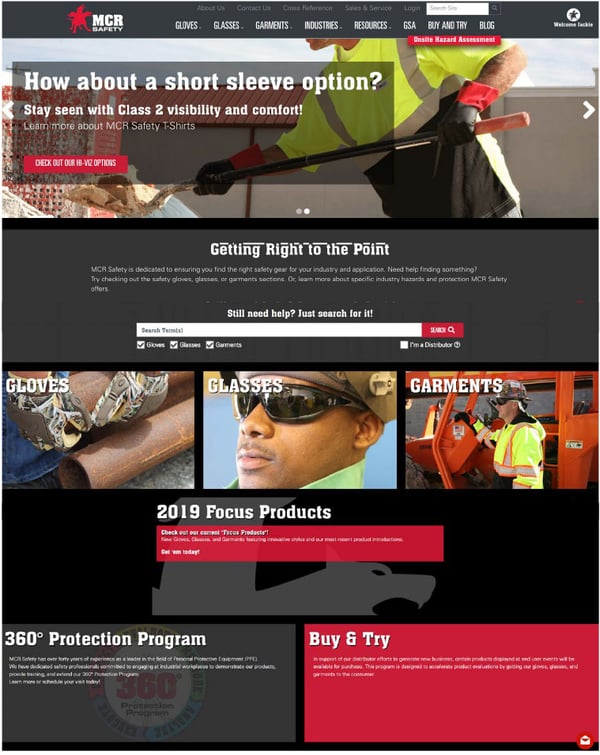

Friction is the tension that website visitors experience on your site. It can manifest in a number of ways, including difficulty accessing certain information, FRUSTRATION with slow-loading graphics or unclickable links, hard-to-read fonts, an inability to get in touch with someone, annoyance with outdated e-commerce layouts, and so much more. Friction is comprised of anything that makes what a visitor is trying to accomplish on your website difficult. You can reduce friction by implementing tools like:
All of these things can help you move your prospect from browsing to buying and coming back for more.


Content should not just be informative, but also engaging and compelling. From animated videos and testimonials to 3D videos like this one, manufacturers are creating some really amazing content to showcase their products and educate their buyers. Diversifying the media you use to communicate with your audience can have a variety of benefits, such as helping you stand out from your competitors, communicating more effectively, and increasing brand engagement.
This is an exciting opportunity for manufacturers because there is still time to be among the first companies that approach content from this perspective in your niche. There are many formats to consider, including printable and downloadable guides, high-quality photography, and various types of videos. Here are over 30 types of offers you can check out to brainstorm some creative ideas for your company to incorporate in its next redesign. I recommend creating some clear calls-to-action that direct visitors to fill out a form to view the offers in order to capture more lead information for the sales team and to create a more personalized experience for the visitor in the future.

Your CMS is your Content Management System, and you will need to find the one that helps you accomplish the goals that you set for your website’s performance. There are many factors to consider when deciding which systems will fit your company’s needs.
Here are some questions that will need to be answered:
In addition to these questions, you should also consider hosting issues (cost, effectiveness, and renewability), the number of redirects that may be needed, overall website structure, and special elements like content libraries or distributor portals. The complexity of your website will need to be matched by the capabilities of your CMS.

Companies that decide to update their websites often make the same mistake: they ask a young, somewhat tech-savvy person to be responsible for updating the website, maintaining the social media accounts, and taking care of content marketing. While this may be the right person for the job, you cannot just expect that people are good at these tasks simply because they are from one generation or another.
Decisions about what to include on the company’s website and how should stem from a set of pre-determined goals and strategies. Otherwise, you could be spinning your wheels and doing things that will need to be undone later, or even worse, could hurt the company in terms of brand or reputation.
Anticipate who will need to be involved in the website redesign process. Who in your company will oversee the website redesign? Will you outsource some or all of the redesign roles to an outside agency? Outside organizations can provide additional guidance, structure, support, and expertise.
Before exploring a partnership with an agency, try to put together as many details as you can in order to prepare for your first conversation. The more information you have available before that first meeting or consultation, the more efficient and successful your search for the right partner will be. You do not need to have all of the answers, but a lot of the lessons I’ve covered here require quite a bit of soul searching and self-evaluation for the company. This can be less stressful if you start that process before you sit down with consultants or designers from an outside company.
I recommend that you keep a virtual notebook. You can do this through a cloud-based document that is easily shareable, noting things you like and dislike about what your competitors are doing with their websites, looking at things like content, communications, technology, colors, layouts, and more. You can also make note of answers to questions I have proposed in this document and highlights from any research you have already completed that I have mentioned as necessary and relevant, like buyer personas and value proposition.

Teachers set deadlines for students because deadlines force the students to get work done in a timely manner. For the most part, a lack of deadlines leads to a lack of productivity. When you are in charge of a project like a website redesign, you are probably setting your own timeline. That can be great as it allows you to have flexibility and control. However, setting your own timeline can also mean that things get pushed to the back burner again, and again, and again.
I strongly recommend setting deadlines that are based on things outside of your control. For example, maybe you would like your site to go live before a big industry trade show. Or maybe you want to have everything ready before an anticipated seasonal uptick in website traffic. Whatever motivates you to complete your work in a reasonable amount time, go for it! Just be sure to allocate ample time and set realistic deadlines that still allow for a good, thorough job to be done and some extra padding for any unexpected events that may cause delays.
Setting a budget is equally as important. Know what you have to work with, keeping in mind that you will likely want to keep a separate budget for premium content for the website like videos and buying guides, as well as marketing tasks that surround the launch.
Most importantly, consider your overall goals. What do you want your new website to do? Are you looking to modernize the website’s look and functionality to better meet your customers’ needs? And does that bring up any other items that need to be worked out before the website redesign begins, such as a rebrand? What if the new website needs to also reflect how the company has evolved over time? Determine the answers to those big picture questions and complete those items before diving into the redesign so you do not create extra work by doing things out of order.

Now that I’ve covered some of the basics of website redesign, let’s briefly consider the ways that website maintenance and analytics have changed over time.
We’ve already talked about how a static website that simply presents the basic information about your company and products like a brochure is not an effective website for today’s buyers. With these changes to design and intention come changes in maintenance and analytics for gaining feedback and measuring success.
That’s where the Growth-Driven Design (GDD) methodology comes in. GDD is all about continuous website refreshes and updates, instead of the approach to website maintenance in the past which focused more on complete redesigns every few years and not many ongoing changes to the website in between those more massive overhauls. Using the (GDD) methodology encourages the consideration of regular future updates and maintenance during the design process.
Some simple but effective examples can include a strong featured image on the homepage that highlights a new industry focus page or section and blocks on the homepage that can be easily updated to drive to new sections on the website and A/B tested for CRO. The refreshed MCR Safety homepage mentioned earlier in this guide is a great example of this.
While it wasn’t quite called GDD, I learned about this strategic approach to website maintenance years ago during my time at Neiman Marcus’ BergdorfGoodman.com as a site merchandiser, where a very diligent refresh calendar was maintained.
It is not rocket science, but it can have a huge impact on engagement and conversions on your website, among other things. The key is actually doing it and most of your competitors likely will not, so this is one thing you should circle, highlight, and star to make sure you do since again, it does not take much work but yields great benefits to your business.

Last but definitely not least: metrics. Metrics and tracking are vitally important to the redesign process, as well as ongoing maintenance and optimization. Below is a succinct list from Torque, a leading resource for Wordpress news, with seven key metrics that you should be tracking for your website.

To determine the success of your website redesign, I recommend recording these numbers for your current website with a few different time periods such as for the past month, quarter, and year before you launch the new site and then compare those statistics to those of your newly redesigned site post launch once enough time has passed to do so. Be sure to prioritize goals and record any other numbers related to your goals. While you should be able to compare these numbers with tools like Google Analytics after launching the new site, it never hurts to pull them before the launch and save them somewhere just in case. Then of course continue to review those numbers on a regular basis moving forward, comparing similar time periods for a more accurate apples to apples comparison.
But there are some other great insights now available to consider reviewing throughout all of this. For example, you can learn a tremendous amount about how visitors are navigating through the website by exploring paths. These will help you determine which factors contributed to various conversions or drop offs on your site and overall visitor activity. Understanding the paths that are successful and the ones that are failing to convert will help you better understand areas to highlight and invest in, versus other areas that visitors are not engaging with and therefore maybe should not be focused on as much in the redesign. Hotjar is a great tool to help you understand your website users’ activity too with things like heat maps. HubSpot also has an endless array of customizable reports for the CMS and other integrated products, but they overall tend to be more focused on search engine optimization and visit, lead, and customer conversion activity in relation to business objectives than more granular visitor activity like you can see with tools like Google Analytics and Hotjar. So all three tools are great and they are more complimentary than redundant in many ways. They all offer good information to review before and after a redesign, as well as on an ongoing, regular basis.
One final related tip I will add here is incorporating user interviews into your redesign research. Just like with the buyer persona interviews, sometimes there just is no replacement for good old fashioned talking to people and asking them some simple questions about how and why they took or are taking certain actions in order to gain a better understanding. You can of course do the same thing during staging and after the launch to improve and compare results, as well as continue to optimize.

Lastly, throughout all of this, I recommend following the advice of Stephen R. Covey in his classic book, The 7 Habits of Highly Effective People. Covey said, “Begin with the end in mind.” When I apply that to marketing your manufacturing company, that means knowing how you want to grow and what you want to do to get there. Assuming your branding is up to date, modernizing your website is your first step in getting your company on the right path to evolving for your buyers’ modern needs and reaching your growth goals.

By taking a proactive approach and thoughtfully planning your redesign, your website can become a valuable tool for your company’s growth. It can lay a solid foundation for your inbound efforts.
For help with your next redesign, I invite you to get in touch with me here at Digital Marketing Direction. My inbound-trained team of developers, designers, writers, editors, and I can help your company successfully navigate a redesign that sets your manufacturing company up for success. Whether you are looking for an advisor to partner with your in-house team or some additional implementation support ahead of launching your inbound campaigns, I would love to have a discussion to learn more about your company’s goals and needs.
You can call me at 214-937-9521 or get in touch via the website. I look forward to talking with you!
 Jackie Connors is the Founder and CEO of Digital Marketing Direction, a top-tiered HubSpot partner agency based in Texas. She provides inbound training, consulting, and managed content services to mid-market companies, especially those in the manufacturing industry.
Jackie Connors is the Founder and CEO of Digital Marketing Direction, a top-tiered HubSpot partner agency based in Texas. She provides inbound training, consulting, and managed content services to mid-market companies, especially those in the manufacturing industry.
15851 Dallas Parkway Suite 600 Addison, TX 75001
17806 IH 10 Suite 300 San Antonio, TX 78257
info@digitalmarketingdirection.com214-267-9344